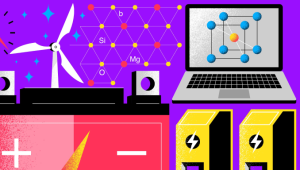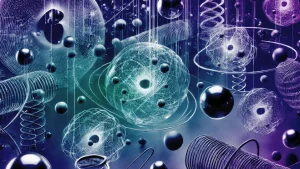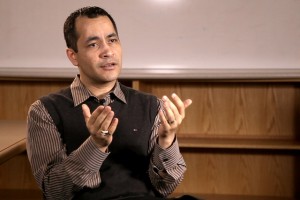Powerful and Lightweight: Materials for Batteries
On the development of battery materials, learning from nature, and enhancing battery capacity and potential
Why do atoms start to radiate coherently in some conditions? What usually prevents superradiance from happening? Why are ultracold polymolecules particularly interesting for scientists? These and other questions are answered by Senior Research Fellow at Harvard University Susanne Yelin.
If we have spontaneous decay in atomic samples, all, every single atom decays at any given time, they know nothing of each other, these different atoms. So if you have, for example, a thousand atoms, their decay is just a thousand times as strong as the decay from a single atom. If you, however, have superradiance, that means that all of them basically line up and radiate together. How does this work?
Usually there is a difference between adding up intensities and adding up amplitudes. Let’s assume we have our light waves are just single sine waves. If we look at the intensity of those sine waves and add up two then we get double the sine waves. But, however, if we add up the two sine waves and then take the intensity of this, it gets four times as much or two squared times as much. And this is exactly what happens with light waves. If these light waves add up in phase (so it means that [if] one oscillates like this, the second oscillates exactly the same – in phase), then they add up and square. So you get four times the intensity. And exactly that is what happens in superradiance. So instead of every little atom doing their own little thing and sending out their photons every which way, these photons they are sent off in a coherent or cooperative manner all in phase. And so, in the extreme case instead of getting thousand times the decay intensity, you get actually thousand squared times the decay intensity. Which is the more atoms you have – quite a dramatic effect. In effect, what happens if you would do that experimentally, usually do it with these diverse atoms you get an exponential fall-off your decay. Whereas if you have superradiance you get a really sharp flash which falls off much faster because of course the total energy that comes out is just the same. It just comes much faster.
So if we have many-many atoms that close together (and what does it mean “close together”? “Close together” means they are much closer together than the size of a wave length), in this case if you have a fully excited atomic sample, and then go one step of excitation down, you don’t know which of the atoms is excited and de-excited. So there is exactly one, so called superposition, namely the one where everything is weighted exactly equal. And then the next step, again, there is exactly one state in which they can go, namely, which is completely symmetric for all of these. And so it goes basically the whole level down.
Quantum mechanics is pretty tough if you, for example, want to do it numerically, because, even if you have only two states, the total number that you have to treat is 2*N where N is the number of atoms.
However of you look only at this symmetric (so called, ‘Dicke states’) in superradiance, you have only N+1 state. The one where everything is excited as the first, so to say, the zeros, and the one where everything is at one state – is the N. So this is from 0 to N, so N+1 different states.
So this is actually very easy, first, to calculate and, second, because of all this radiation that comes out, now basically goes exactly in one channel, it has a very easy time lining up in this way and therefore ending up to N squared.
This should be pretty easy. Experimentally you just take a sample of atoms, you just put them very close together and let it decay and you get this out. Why doesn’t this work this way? Of course, in reality there is much more to that. The strongest effect that keeps this superradiance from happening is that there is the so-called dipole-dipole interaction. It means if you put these atoms so close while they decay, they interact with each other (this distance depends on one over distance to the third order). And it means that the ones which are very close interact very strongly, the energy changes a little bit. The ones that are little bit further apart interact not quite so strongly. So the energy changes a little bit less. And so you get a wide spread of energies. And in the end these energies they don’t fit together anymore. And so this kind of nice adding up of these waves just doesn’t work anymore. And this is actually for a long time that has been the reality in all the experiments which have tried to see this. It was seen, but this clear dependence was barely discernible over the noise, so it all was not really quite conclusive.
And one of the problems was also, at the same time, that to describe this system, theoretically from a point of view that can’t be realistically compared with any set-up in an experiment, was very hard, because if you take all these dipole-dipole interactions into account, you are back from your nice kind of N+1 states to the 2^N states. And there is not computer yet where you can do that for a reasonably big amount of atoms. So people tried all kinds of approximations and, eventually, they actually got good enough that this can be compared. And, at least to my knowledge, the first time that superradiance in its pure form was seen was actually accident. In fact, this was, I’d say, in 2005 roughly. By that time people wanted to see a sample of, so-called, Rydberg atoms. So, Rydberg atoms are very-very highly excited atoms which should be relatively stable. The problem was they were not stable. So the idea is to excite them up they stay for a couple of milliseconds before they decay again. The problem is they didn’t stay for a couple of milliseconds, they only stayed for a couple of microseconds. And people were really puzzled, they couldn’t understand what the heck was happening in this case. It turned out after trying a lot of things that what happened was actually superradiance.
What happened is that because this Rydberg atom stayed very high excited, but up there the energy levels are very-very close together. What does that mean? The transitions have very long wavelengths. So basically every sample that you can have is very small compared to these long wavelengths. And so superradiance is actually quite likely in these cases. And this is actually exactly what happened. As I said, it was an accident, I don’t think it could have been done such an ideal experiment on purpose in this case.
So let’s go a couple of years further, closer to the presence. In the meantime, the research on Ultracold Polar Molecules, or Ultracold Molecules, in particular, has become quite advanced and quite important. Polar molecules: their specialty is that they have many different hierarchies of transitions energy-wise. So they have transitions in x-ray. They have transitions that go to the visible lights. And they have the so called vibrational transitions which are somewhere between microwaves and terahertz waves.
What have we learnt from that? First of all, unfortunately superradiance is still something which is hard to control. It happens, but it’s very hard to control. So, research in the future would really go into how can one geometrically and system-wise set up the experiment to actually see it and potentially take advantage of it. The second thing, the other side, is how we can make sure that superradiance doesn’t always show up accidentally. And the guess is that in fact for nearly all of the polar molecules, that people study experimentally right now, superradiance for these vibrational transitions actually would play a major role and definitely would have to be taken into account.

On the development of battery materials, learning from nature, and enhancing battery capacity and potential

How to power devices with virtually no losses

Bioengineer Ali Khademhosseini on cells' environment, gene circuits, and directing differentiation